|
May 1 - Tuesday - Crossing the Border - Goodbye to Ahmed
Wake up call at 5, breakfast at 6. We boarded the bus and left the hotel at 6:30 and started across the desert.
The calm, crystal blue skies from the day before had turned into dust storms giving us hazy views and dust in our nostrils. Thank goodness we got to see Petra in such bright sunshine. Today, I felt trapped in the bus and trapped in the landscape, with scenes from “The English Patient” taking over.
We were shielded from the wind in our mini bus. Ahmed opened his heart and shared his stories. His theme is that people are good; politics screws us up. Anytime we came close to stirring up the radical Jewish contingent in the group (you know who you are), we changed the subject to “Tell me about tomatoes.” Everyone loved Ahmed, no matter your political / religious background.
After a couple of hours of driving, we made a pit stop at Mid-Way Castle to drink, eat, pee or buy souvenirs. We got out of the bus into a chocking sand storm. I was depressed by the desolate landscape and couldn’t imagine how people could carry on here – or how hundreds of years ago caravans of 2,000 camels made their way slowly across the desert (without the protection of a mini bus and guide). The Mid-Way Castle was a nice, big store with shelves loaded with stuff. However, there were no customers in sight. Need I tell you, tourism in the Middle East is in a nose dive? I almost bought some bowls, but the idea was nixed by Bill. Probably wasn’t a good idea anyway.
As we got closer to the Jordan River crossing, military bases sprang up everywhere – lots of them. At the first checkpoint, happy-go-lucky Ahmed (forever social and greeting his pals with big hugs and kisses) became sober and serious. The guys holding rifles outside the gate weren’t his “brethren.” They were Israelis in a place where conflict is bred into the genes. The only thing the guards shared with Ahmed was a look of scorn.
The bus parked just outside of customs to let Ahmed out – Israelis would never let him into their country. On that grey hazy dreadful day, we each said our good-byes to Ahmed. Tears welled up in his huge passionate eyes (and in mine too) as he said, “We started as a tour group and ended up as a family.” I resisted saying to him, “next time you’re in US, look us up.”
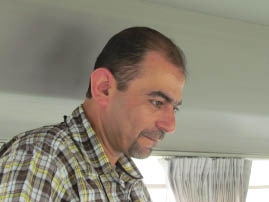
Ahmed saying "Goodbye" |
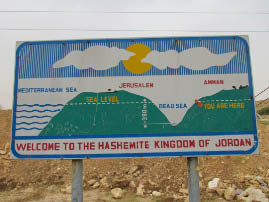
Welcome to Jordan--actually we're leaving |
We were left with the bus driver in “no-man’s land,” crossing the pitiful little King Hussen Bridge over a riverbed with a little mud that passed as a stream and called itself the Jordon River – what a stretch. Why do countries fight so fiercely to protect such insignificant boundaries?
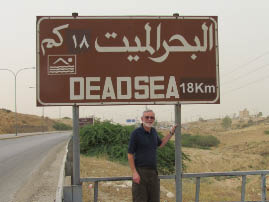
Bill in "no man's land" |
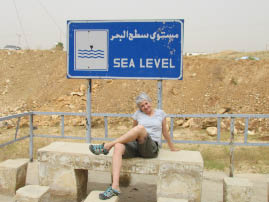
Nancy at altitude 0 |
Our timing was really bad as we came to Israeli customs. We were stuck behind 3 or 4 large tour buses and had to sit patiently in our little mini bus for a good two hours. The continual hazy, sand storm didn’t help our mood. We are sharing a nightmare that didn’t seem to have an ending. Luckily I was able to bury myself in my new book, “Married to a Bedouin” to divert my attention.

Waiting for Israeli Security |
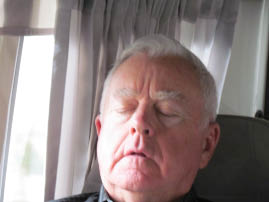
Don resting up for the Keystone Kops |
When we were at our wits end, a sexy Israeli guard came out of the official-looking building and walked up to the bus. She said that we could skip customs and go directly to the passport control. Hope was with us again. However, passport control turned into another nightmare. Without Ahmed, we were a leader-less group. The gals at the passport gates weren’t like the Israeli tight security that I had imagined. The three that we dealt with wanted to flex their muscle and show who was in charge. However, from their interrogation behind the window, they appeared more like the Keystone Kops shooting questions and demands at us without even thinking: “Let me see your itinerary, your flight information. What hotel? What dates?” Joann threw them a curve ball when she asked not to have an Israeli stamp on her passport. That just triggered a lot of other questions. Finally we made it through passport control and waited outside the building for Yael, our new guide. The weather hadn’t changed from Jordan to Israel – still hot and windy with sand blowing everywhere -- very oppressive. We made a call to OAT and then Yael appeared. We now had a leader and hoped to be functioning again.
We boarded a bigger bus with our new leader to drive to Tel Aviv. Yael pointed out things of interest along the highway. I couldn’t see Jericho because it was too hazy. I couldn’t hear about the massive settlements that appeared as giant condo complexes lining the hillsides, each one to ensure that either Arabs or Jews (not both) dwelled within the confines of their own fortified cities.
The bus climbed steadily from the brown deserts of Jordon to the top of a mountain, where Jerusalem, the Holy City, sits. The landscape changed dramatically to fertile valleys of olive trees and grape vines with a smattering of yellow and purple wild flowers tossed in for color. This is indeed the Promise Land. I did catch a peak of Jerusalem’s shining “Dome of the Rock.” In this ancient (and modern) city, Bedouins still herd sheep and goats and live in tents along the easement of the snaking freeways. From time to time, I caught a glimpse of the wall and the West Bank carving up the land. It was way too much to process all of these things in my brain-dead state.
I was struck by thousands of Israeli national flags proudly displaying the Star of David, lining the highway all the way from the Jordan border into Tel Aviv. I thought this was a powerful symbol that was making some clear statement like “Don’t mess with Israel.” However, Yael said the flags were left over from celebration of Israel Independence Day – so I took my imagination out of overdrive.
Just about sunset, we hit rush hour traffic in Tel Aviv as we headed to the heart of the city and to the Center Chic Hotel, only about 5 blocks from the Mediterranean. The hotel is a funky old bauhaus building on a lovely tree-lined square, right across the street from its sister hotel, Cinema Hotel, another bauhaus design. Our hotel is very cozy, clever and well designed.
We went to our small, compacted room and tried to reorganize our life, picking through our basic necessities sealed tightly in plastic bags. Bill was on a mission to do the laundry.
We trotted down to the low-ceiling “Happy Hour” room, wedged in above the entrance and lobby. It was just like the half-floor space from the movie “Being John Malkovich.” The height of the room worked for everyone in the group – everyone except Tom, that is. He was the tallest and had to bend down to fit it. We started Happy Hour at 5:30 with great hors d'oeuvres and wine – all free. The rest of the group joined us at 6:30 -- We are now 16. Yael is a way cool, smart tour guide.
For dinner, we walked a few blocks down to the main promenade on the Mediterranean. Our restaurant was outdoors on the beach and the white fish was excellent. We sat with Carole and Rich and Joann. Yael had a welcoming celebration and handed out buttons to the returning, faithful OAT customers. It was a delightful, fun evening. We got back to the room at 10, happy that the border ordeal is over and ready for our Israel adventure.
May 2 – Wed – Tel Aviv
We crossed the street to have breakfast at the Cinema Hotel. It was good – but no omelet bar and I love omelet bars. There was plenty of food to make due.
We left at 8:30 a.m. to drive a few miles south to Jaffa, a 4,000-year old city. It was once a wealthy ancient port and where the story of Jonah and the Whale originated. Turns out that Jonah got on a boat to flee from the city because he didn’t like the neighbors and was distancing himself from God. A terrible storm came up and the soldiers threw him overboard. The storm calmed. Instead of drowning, Jonah was eaten by a whale. One flaw in the story – this place doesn’t have whales, so it must have been a really big fish that gobbled him up. Jonah stayed in the belly of the very big fish for 3 days, until he repented and praised God. Then God made the fish regurgitate him. (Even as a naive kid, I had a hard time swallowing this fish story.)
We walked through the Old Town of Jaffa past the Clock Tower and St. Peter’s Church. Goofy Napoleon cartoon figures scattered throughout the square had signs, pointing the way to the main attractions. In 1804, Napoleon ripped through Jaffe, conquering and killing every living thing in sight. It turned out to be a very bad strategy because the piles of rotting bodies scattered about created diseases and plagues that eventually infected Napoleon’s troops. Because of the dwindling troops, Napoleon had to take time out to build a hospital and regroup. The weakened troops were eventually conquered and Napoleon was forced to retreat.
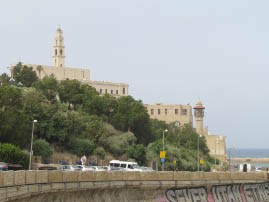
Jaffa from the beach
|
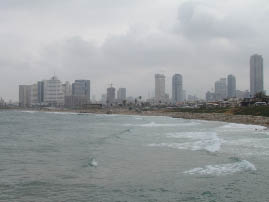
Looking back at Tel Aviv from Jaffa
|
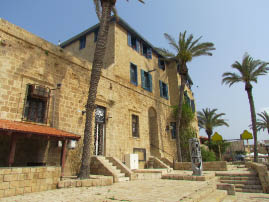
Church in Jaffa |
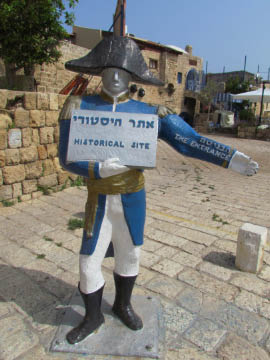
Nepolean greated us |
We walked into St. Peter’s Church where a Friar was dusting the large candelabras. I always like to see signs of life in these empty old wind tunnels. These churches aren’t really local worship centers, like the churches we know back home. They were built to commemorate certain biblical events giving folks a destination for their spiritual journeys. This place doesn’t get used often. However, it is rented out regularly by a group of Filipino maids.
Yael sat us down in the pews to give the story of St. Peter’s Church. Paul wrote the chapter of Acts in this church, describing what happened to the disciples after Jesus went on to heaven.
St. Peter was crucified in Rome upside down. Peter’s story was that one day he was very hungry, but couldn’t eat anything because all the available animals around were “unclean.” He had a perplexing vision that God only created clean animals. At the same time, Cornelius, a good Roman Centurion Samarian, living in Caesarea miles away, hooked into the same vision. Later Peter would get together with Cornelius and help save the uncircumcised gentiles who were also “unclean.” (I’m sure there was more to the story than that.)

St. Peter’s Church |

Inside St. Peter’s Church |
We said good-bye to St. Peter’s and walked around the corner to the Ilana Goor Museum. A cute little guide led us through each room. The museum happens to be Ilana’s private home and located in a 4,000 year old structure that is part of the ancient city’s walls. It’s been re-designed over the years and maintains its incredible views overlooking the Mediterranean.
Ilana wasn’t at home when we visited, but her big slobbery dogs were. They added to the ambience. Each room knocked my socks off with pieces of her work blended in with ancient artifacts from places like Africa and China – things she had collected over her lifetime.
Ilana is about 75 and a very famous Israeli artist, designer and sculptor. She never formally studied art, but there isn’t anything she can’t do and do well – jewelry, furniture, glass, pottery, bronze, iron, etchings, paintings and carvings.
She was born into a well-known family of doctors, many of whom were also artists. She began sculpting in Los Angeles in the late 60’s. In 1983, she scored big time when she designed buckles and sold them to most major department stores in America including I Magnin, Neiman Marcus, Bloomingdales, Macy’s and Saks Fifth Avenue. More successes followed with her line of furniture and jewelry. It didn’t hurt that she married a ga-zillionaire who made his fortune selling popcorn and soft drinks at movie theatres.
Nobody in the group wanted to leave Ilana’s house – except for Bill maybe. Yael finally managed to gather us up to continue our tour of Jaffa. We walked through the ancient town center and stopped to see a floating orange tree. It was a creation of Ran Morin, an Israeli artist. He’s known for his work using full size living trees. He has a tree statue in London’s Regent Park as well. The tree is growing out of the pitcher, trying to break it, pointing out the increasing world of separation between man and nature, as "creatures that grow in containers." God, don’t you love these artists?
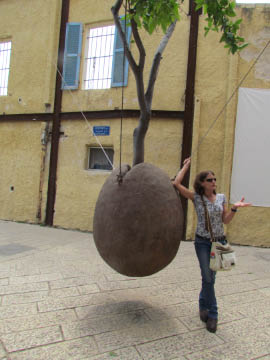
Yael by Floating Orange Tree |
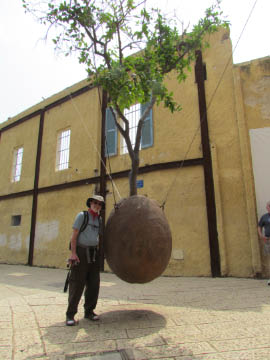
Bill by Floating Orange Tree |
We had about 20 minutes on our own to stroll through the Jaffa Flea Market. All I remember seeing is a bunch of old Barbie dolls intermixed with full-on junk.
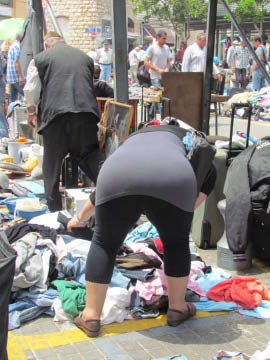
Jaffa Flee Market
|
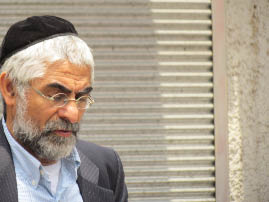
Jaffa Flee Market |

Jaffa Flee Market |
We had a home-hosted lunch at Doris’ house on the outskirts of Jaffa. Doris started out by apologizing for wearing black. Believe me, there was nothing to apologize for because she looked very sexy in her tight black satin jeans and her low cut top. She was mourning her mother-in-law’s death just a week before.
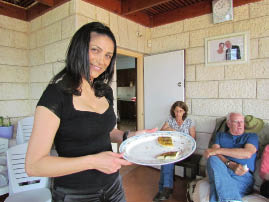
Doris Serving Lunch |
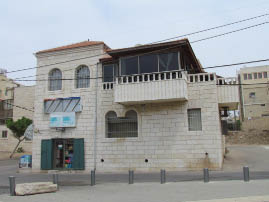
Doris's House |
The lunch was delicious – fresh and simple – and her talk was moving. OAT picked her to represent the Christian sect that survived the demise (and now rebirth) of Jaffa.
Doris is 38, has 3 children, and is married to the son of a major coffee manufacturer. Doris told us about her early days as a child in the mixed Muslim-Jewish-Christian neighborhood. In the 1970’s Jaffa declined causing many families to leave. In spite of the crumbling hood, her family decided to stay. The houses quickly turned to rubble and the beach became a dump. Along with the decay came crime and drugs. Now the place is turning around. The house is lovely and you can use the beach again. (She takes the kids to this beach, but when she wants to wear her bikini, she goes to the with-it beach in Tel Aviv, just a mile or so away.) She thought she’d never see the neighborhood come back again and is thrilled to have children be a part of it. She and her family are doing very well now.
When she was 16, her mother sent her off to buy coffee. The owners of the coffee business were impressed with this adorable kid and wanted her to marry their son. At that time she was very innocent in the ways of the world and wore no makeup and no sexy clothes. After the offer, she agreed to get to know the son and had chaperoned dates for a couple of years. Her older sister was the chaperon and ended up marrying another brother in the coffee business.
Her story was riveting and honest. Someone in the group asked if she was happy with her “arranged” marriage to the coffee son’s owner. She replied that he is a good man and a good father. She has a good marriage, but there is no "feeling". In spite of her beautiful talk, half the group was suffering from jet lag and fell fast asleep. The collective assessment was that Doris was one heck of a woman – intelligent with an excellent business sense and called the shots. She also designed the coffee packaging.
Our next stop was Tel Avis’ center city and the Bauhaus tour.
Tel Aviv was founded in 1909 as a planned “garden city” on the Mediterranean coast near the ancient port city of Jaffa. I expected not to like Tel Aviv because of its lack of ancient ruins, its large population (about 1/3 of Israel’s population), and my media image of a city filled with drab gray buildings. However, it turned out that I was wild about the city. It’s where the action is – the beautiful Mediterranean lapping up on clean beaches full of white sand and plenty of hip coffee shops, cafes and nightclubs. It’s the place to be, especially if you’re young, stylish and have a “with-it” “attitude.”
In Pre-World War I, it was Turks (from the Ottoman Empire) who were in power and dominated the region. They raised havoc in Jaffa, the ancient port city we visited earlier in the morning, but ignored Tel Aviv because it was just an empty beach with a lot of white sand dunes. In 1909, just a little over 100 years ago, that all changed when 60 Jewish families settled on the once empty banks. The settlement would become Tel Aviv, the first all-Jewish city in modern times and would grow to be the second largest city in Israel (after Jerusalem). Pretty remarkable because when it was founded, Jews governed themselves for the first time since the destruction of Israel by the Romans 1900 years before.
The settlers were Jewish immigrants from Bulgaria, I believe, and created a planned city with a socialistic flare. Plots for two rows of homes (enough room for 60 houses) were laid out, running east from the Mediterranean. The section in between the rows of houses was reserved for a large garden. The clever city planners knew that this strip of land, with an underground stream bed, was perfect for trees and plants, but not for houses that would eventually settle and sink. The founders divided the land fairly and then each family drew a shell marked with their assigned lot number. Our group walked between the houses along the “garden area,” now a lovely promenade and park – plenty of room for biking, dog walking and picnics under the trees. This is urban planning at its finest.
David Ben-Gurion, the father of Israel, had a hand in establishing the city (1910) and his modest house is open for tours (although we didn’t go).
About 1914 the Turks kicked out most of the Jews from Tel Aviv and Jaffa. However, the Turks were later defeated in the First World War (1917) when the British invaded Israel and got the spoils of war. Then the Jews returned in great numbers.
Times were tough for the settlers after World War I. In the 1920’s, the place was flooded with immigrants (many Zionists). There wasn’t enough housing or businesses to support the great influx. The wealthy Baron Edmond de Rothschild, from Paris, decided to help Israel. Along with lots of major projects (water plants, roads, and other infrastructure), he took on this settlement (Rishon LeZion). When he died in 1934, he had purchased 125,000 acres of land and more than 40 settlements. He ran the projects like businesses, both offering jobs (and salaries) to the residents and collecting money for services. He didn’t give away money, but he was certainly a savior (or is it saver?).
In the 1930’s, more and more Jewish settlers fled to the area as Hitler’s reign of terror escalated. Economic struggles mounted. Cheap, affordable housing and an infrastructure for the rapidly growing population was a must. Also, funds were needed for the Jewish forces to deal with the Arabs. Finally, in 1948, Israel won independence with the local hero, David ben Gurion as the new leader. Because Jerusalem was occupied by Jordan after Israel became an independent state in 1948, Tel Aviv became the temporary capital and home of the government offices. Tel Aviv is still home to foreign diplomats from countries (including the U.S.) that don't recognize Jerusalem as Israel's capital.
The population growth of Tel Aviv can be summed up as ESCALATING. Starting with 60 families in 1909, the population in 1921 was 45,000. Twenty years later, in 1941, the population grew to 145,000 as refugees from Nazi occupied Europe came in droves. In 1948, the year of independence, Tel Aviv had 200,000 people. Now it has about 1.1 million folks and is still growing by leaps and bounds. Currently, the city is dealing with large numbers, about 50,000 to date, of African illegal immigrants coming up through Egypt. It is a real problem.
In the 1930,’s the solution to the housing storages was the white Bauhaus buildings which dominate its architectural landscape, hence Tel Aviv’s nickname “The White City.”
Because of the 4,000 plus Bauhaus buildings spread over the city, UNESCO declared a potion of the city of Tel Aviv a World Heritage site in 2003. Most of the buildings were erected in the 30's. By 1933, many of the Jewish architects (like Arieh Sharon) who studied at the Bauhaus School for Art and Design in Germany, immigrated to Israel and established the architectural style for the new city. Both the emigration of these Jewish architects and the closing of the Bauhaus school in Berlin were a result of the rise of the Nazi party in Germany.
The Bauhaus architecture used inexpensive building materials with an emphasis on functionality. The houses have simple, clean lines, white walls and no unnecessary decorations. They all have distinctive small rounded balconies and functional floor plans designed to house the workers’ families and yet provide common areas.
After their heyday, Bauhaus’s were neglected for years because people thought they were gray and ugly (myself once included). They are now just being re-discovered. A lot of effort (and regulations) are made to preserve this unique architectural style. Yael said that if developers want to put up a multi-story building, they must remodel one house on the property before they can add a high rise. We walked by many examples. I like the nice, uniform look they give the city.
After the Bauhaus tour, some of the group took a cab back to the hotel. We continued our walking tour of Tel Aviv’s Old Town with a visit to Carmel Market – the oldest food market in Israel. Yael gave those of us left money from her “discovery” fund to buy a snack for tonight’s Happy Hour -- cheese, olives, nuts, dates, etc. I got the olive assignment, my favorite.
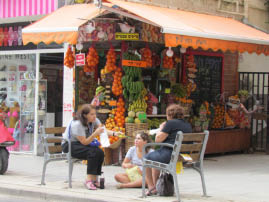
Carmel Market |
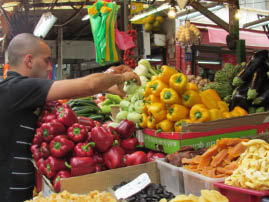
Carmel Market
|
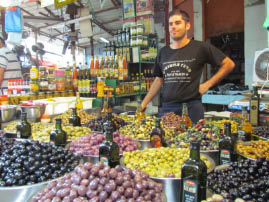
Carmel Market |

Carmel Market |
We got back to our room, showered and headed over to the sister hotel -- Cinema -- for happy hour on the rooftop. The rooftop was nice, the treats were tasty, but no wine. We all whined about having no wine. How could we be happy at happy hour with no alcohol? We sucked it up and nibbled on the treats and the goodies we purchased from the Carmel market.
For dinner we loaded on the bus to drive to the city of Bnei Brak outside Tel Aviv to go to a Yeshiva (Jewish religious school) to hear the Ultra Orthodox Jewish side of the story. Yael briefed us on what to expect. None of us were equipped to ask any meaningful questions on the current Jewish Orthodox issues.
We had dinner at the yeshiva, where the local scholars study. The food was lousy -- soggy meat and soggier potatoes dotted with chick peas – everything was drab and brown.
David was our host and spokesman for the Jewish Ultra Orthodox community. He was 20 years old -- a cute enthusiastic kid and his English was excellent. His dad was from Massachusetts and his mom from Switzerland. His parents came to Israel to embrace Judaism as it was practiced in the 17th century and bare a big family (about 7 or 8 offspring). David stood at a lectern during the whole dinner in that musty room and explained the logic and righteousness in the Jewish Ultra Orthodox views he held onto so tightly.
He told us that:
There are 613 rules he follows and the 613 strings that dangle beneath his shirt remind him of all the rules. He didn’t have to obey any of them until he was 13 years old. Being the rule breaker I am, I wondered how in the world can anyone remember 613 rules?!?! And what the heck are they?
He explained that all the rules had logic behind them. For example, he can have cheese and meat separately, but not together because a nursing cow gives dairy products and you should not harm any life giving thing. I guess it’s OK to kill a non-lactating animal. For this reason, cheeseburgers are out, but hamburgers are OK.
A matchmaker (or parents) will select David’s wife. It’s better that way because it’s easier to have only a couple of choices then have to check out a lot of girls. He used the example of only having to pick between chocolate and vanilla ice cream, instead of all the varieties. Now that makes perfect sense to me.
During the question and answer period, I asked about his cell phone and was that considered new technology. He was OK with the cell phone because he uses it for phone calls only. He showed me that it is not hooked up to the internet where evil information can get into the hands of children.
Bill asked about gay people in his community. “Not a problem,” he said confidently. “There are operations that can fix that.” We gave him a look of horror, but nobody wanted to ask any follow up question.
In spite of his limited view, David was sweet and nobody wanted a confrontation. He’s just a kid with a goal to study and someday become a rabbi. Yael later explained the problem with these sweet kids. The government (and Israel’s taxpayers) have paid dearly and institutionalized the Jewish Ultra Orthodox way of life. Beyond the age of 13, the boys don’t go on to school, but spend their time studying the ancient books. They are not trained for any work. They embraced being poor, marry young and produce as many children as possible. Both the men and women are exempt from serving in the military. Therefore, they can get work permits and have very limited job opportunities. The men have no viable careers. They live off government welfare. The wife must work to supplement the income. Although they denounce the government, they have learned to vote in blocks for their own self-interests. We know what it’s like to have a minority religious group hold the whole government hostage. Yael said one cannot reason with anyone who has God whispering in their ear.

Nancy with David |
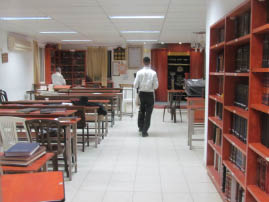
The Yashiva |
[In July, after our trip, the Israeli Parliament considered a law to eliminate the exemption of the Ultra Orthodox from military service. This issue proved so contentious that the ruling coalition between Likud and Kadima fell apart over it. As far as I know, the law has not been changed.]
It was a very interesting evening and an interesting day. We went back to our room with our brains exploding with information.
5/3/12 - Thursday - Tel Aviv / Caesarea / Nazareth (bus break down)
After another nice breakfast at the Cinema Hotel, we loaded onto a comfortable, roomy bus. We traveled north along the main freeway (#1) toward Nazareth, making stops along the way.
Our first stop was Caesarea, where Herod the Great built a remarkable artificial port—an engineering marvel. Many of the Roman ruins here were transformed into a walled Crusader's city in later times.
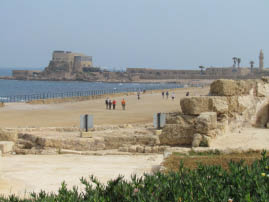
Caesarea |
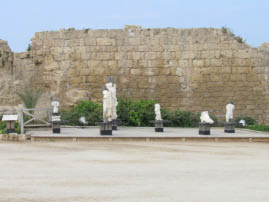
Caesarea |
Herod was a clever politician (with friends in high places) and received a plum political appointment for this new territory. However Herod was paranoid and ruthless.
We started our exploration in the 5,000-seat theatre facing the Mediterranean Sea. The theatre is Roman style – nothing Greek here for Herod to remodel. It would have been nice if the black canvas hadn’t blocked our view of the crystal blue Mediterranean. A tour group of Christians singing “Amazing Grace” down by the stage stirred my very dormant Bible belt roots.
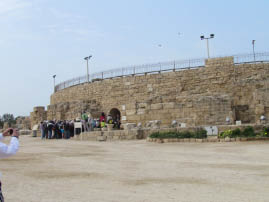
Caesarea |
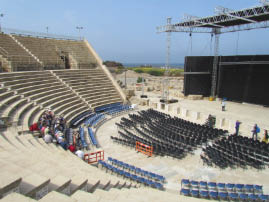
Caesarea |
Roman’s built their theatres for pure entertainment – circuses and freak shows – very low brow, not like the Greeks. The goal of Roman entertainment was to sedate the masses. It’s been documented that the council met in Rome when the empire was experiencing a spike in crime and unemployment. They voted to establish a policy of free baths and theatre performances – 24 / 7. You don’t want a bunch of soldiers running around with nothing to do – free baths and continual shows are much better than causing a ruckus.
Herod was very clever at making the place look grand while using inexpensive materials. Stones were brought in, plastered and painted to look like marble. There was a broken, unimpressive marble stone with writing on it that tied to the place to Pontus Pilot – famous for doing Jesus in.
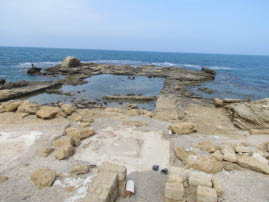
Caesarea |
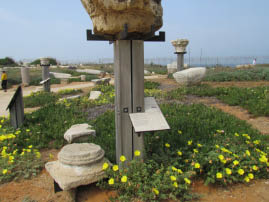
Caesarea |
We walked to Herod’s Palace perched right next to the sea. His fresh water, Olympic-sized pool was installed right on the water’s edge. He loved showing this place off. As he got older, he got more paranoid. He would invite friends over for a visit to the palace. They would drink lots of wine and then go in for a swim. Herod was easily able to have the drunken ex-friend drowned. He also killed his favorite wife and several sons. However he did miss his wife and rationalized her demise by claiming that he gave her a very nice funeral.
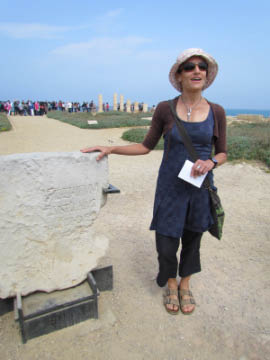
Yael at Caesarea |
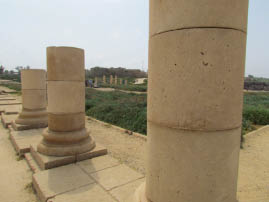
Caesarea |
Herod was responsible for a lot of deaths. He heard the rumor that a male child born would become King of the Jews, so he ordered all male Jews under 2 executed. Many baby boys were killed. Fortunately of Christianity, Jesus hadn’t been born yet. He was born just after Herod’s death.
From the palace, we walked to the 30,000-seat Hippodrome. It once held scenes of Chariot races, gladiator fights and lions eating Christians. Today it’s filled with noisy school kids on field trips kicking soccer balls around.
It was against Jewish law to attend events at the Hippodrome, but many Jews didn’t want to miss the excitement and action. The Jewish guys rationalized claiming that they must attend in order to cheer for their buddies. Loud audience applause meant that the emperor might give a “thumbs up” and spare the life of a friend. Also, some went to witness the death of their colleagues so they could tell the widow. She could only remarry if someone testified to him that they saw her husband die.

Hippodrome at Caesarea |
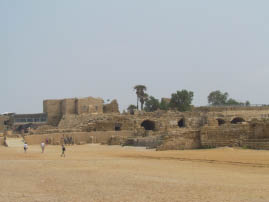
Hippodrome at Caesarea
|
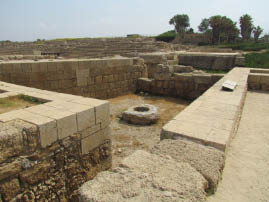
Hippodrome at Caesarea |
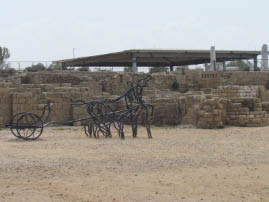
Hippodrome at Caesarea |
The original Hippodrome was probably too close to Herod’s palace, maybe too much noise mixed with animal smells, so it was moved. That opened up an area for a nice Roman neighborhood with houses featuring lovely Mosaic tile floors.

Roman House |
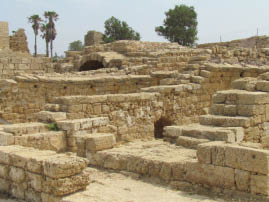
Roman Neighborhood
|
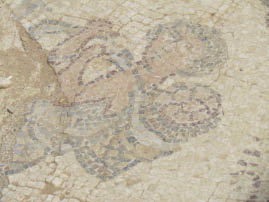
Roman Tile |
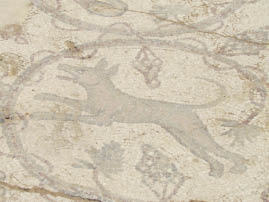
Roman Tile |
We continued our walk to the Port of Caesarea. There was never a natural harbor for a port along this coastline, but nothing stopped Herod. No one thought it possible to build an enormous functioning port here, but by golly, the Romans did it.
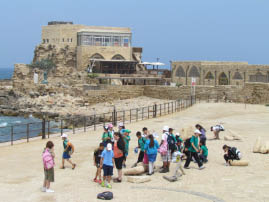
Port of Caesarea |
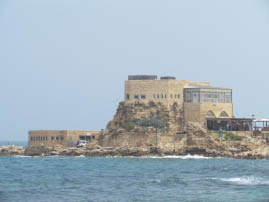
Port of Caesarea
|
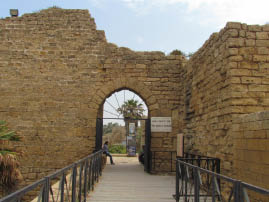
Caesarea |
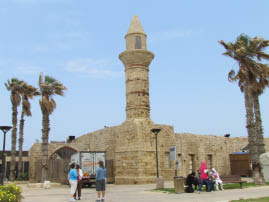
Caesarea |
Later the Crusaders (ignited by Helena and her son Constantine) would conquer Caesarea and recycle the marble for a huge Crusader Castle. It was massive and seemingly impenetrable, but the Turks would have their turn at conquering and destroying the Crusader Castle. In modern times, after the city lay in rubble, Rothschild would come to save the day and turn it into a National Park – and a place for families to come on holiday and go to concerts.
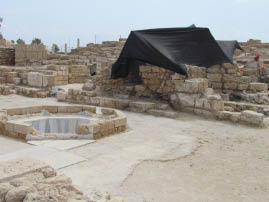
Caesarea |
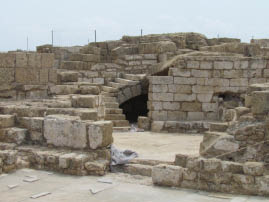
Caesarea
|
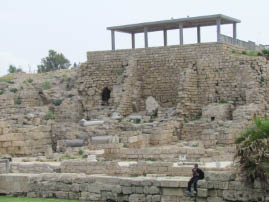
Caesarea |

Caesarea |
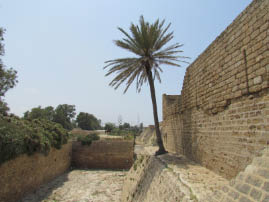
Caesarea |

Caesarea |
Before we left, we watched a very creative orientation video all done in CG, with that “Avatar” kind of look, depicting what it must have been like a couple of thousand years ago.
Back on the bus and back on Highway 1, we headed to Haifa. Wouldn’t you know it, the bus broken down, right on the freeway. We inched along, then had to stop from time to time to cool the engine down. It was pretty scary with all the traffic zooming by. We finally made it to our fast food stop. The food was good – and we wandered down to a convenience store to buy a beer – not an easy feat in Muslim-land. A brand new bus was sent to retrieve us. Our bags didn’t fit in the new, smaller bus. They had to travel on their own in a separate vehicle to Nazareth. We were only delayed about an hour.
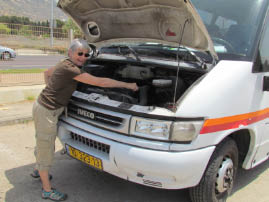
Nancy's auto repair skills were not enough |
We drove to Haifa, Israel’s third-largest city. The city spills down the slopes of Mount Carmel to the busy harbor which once was an ancient seaport. We stopped at the terraced Bahai Gardens on the slopes of Mount Carmel, high up on a hill for a panoramic view of the Mediterranean Sea.
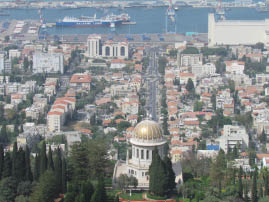
Haifa from the Bahai Gardens |
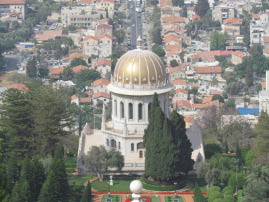
Haifa from the Bahai Gardens
|

Haifa from the Bahai Gardens |
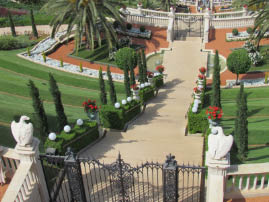
Bahai Gardens |
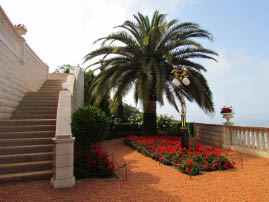
Bahai Gardens |
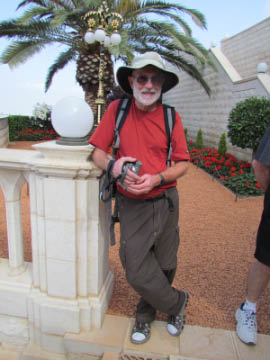
Bill at Bahai Gardens |
We learned about the Bahai religion – sounded like a cool thing to believe in. Nineteen is a very important number. (The guy at the gate had an official badge with 19 pedals.) There are a lot of wealthy Bahai members and they all donate 19% of their income.
Background:
The Bahai Faith is a monotheistic religion founded by Bahá'u'lláh ("buh-howluh") in the 1860s in Persia. Today, there are five to seven million Bahai’s worldwide, most of them live in non-Muslim Third World countries.
Like Jews, Christians and Muslims, they believe in only one God and have their prophets as his messengers. They pray daily, avoid alcohol, read the scriptures, work hard as a form of worship, promote education, and strive for social justice and equality. They have an annual fast, along with a communal feast held at the beginning of each month in the Bahai calendar. They have no priests or preachers. Local and national elected councils -- Spiritual Assemblies -- make the policies with the final say given by the Universal House of Justice headquartered right here in Haifa. Other key locations are India (1.7 million), USA (750,000), Iran (463,000), and Vietnam (356,000)
I liked their general take on life with the assumption that human nature, or the soul, is good and the purpose of life is to develop spiritually and draw closer to God.
Yael believes that since it’s a relatively new religion and because of that, humans haven’t had time to muck it up.
We had to forego Elijah’s Church in Haifa because we were running behind schedule. We drove directly to the Greater Galilee Olive Oil Company, an olive farm owned by Ehud and Shosh Yonay.
OAT, our tour company, arranged for our group to have dinner and a talk at Kfar Hasidim, a cooperative farming village. The northern region of Israel is the center of the olive harvest. The olives here are virtually the same olives eaten at the time of the Jewish Temple. Despite the turmoil in the region, harvesting olives has been done by people of all faiths -- Jews, Arabs, Druze and Bedouins -- for thousands of years.
We arrived late. Shosh, originally from Morocco, was our host. She runs the farm with husband, Ehud. She gave Yael a big Mother Earth-like hug and led us to the large enclosure in the back. The quiet twilight hours settled on the peaceful little farm. The place had great vibes.
We were seated in a circle around Ehud. He looked frail and weak as he began his story about his family and this very special place.
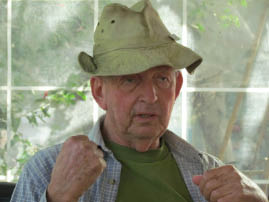
Ehud Yonay |
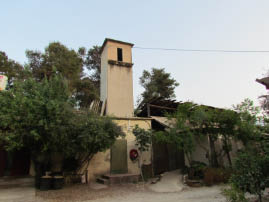
Greater Galilee Olive Oil Company |
Ehud’s great uncle (Yabona Rabbe), a young rebbi, led of group of Hasidic farmers from Poland to Palestine. In 1925, he founded Kfar Hasidim. They turned marshlands into olive groves and formed a cooperative farming village. Ehud’s mother was the daughter of the rebbi and his father was a mounted ranger who wrote two books about the Bedouins. He built their farm on a Frontier Fortress in the 1930’s where young Ehud grew up.
Ehud was a storyteller extraordinaire. He told a story about being 6 years old and finding a gun (like Wyatt Erp’s) and becoming part of the IRA. We were mesmerized by his soft-spoken, well-chosen words. We didn’t want the stories to end and begged him to write a book. He waved us off and moved slowly to the house, leaving Shosh in charge. As soon as he was gone, she asked us if he told us that he had written the story that inspired the movie, Top Gun. We were all blown away. The movie was based on an article "Top Guns," he wrote for the May 1983 issue of California magazine. That sly little storyteller had duped us into thinking he had lived out his life on this quiet little farm when in fact, he spent a good part of his time in California as a writer/journalist. He also wrote the book, “No Margin for Error: The Making of the Israeli Air Force (April, 1993). Never judge a book by its cover.
By the way, Ehud married Shosh 13 years ago. They first met when Shosh dropped a school paper written by her daughter at Ehud’s apartment. He requested it for his research. It was love at first sight – so intense that he canceled a flight to the U.S. scheduled on the next day. Instead he stayed in town to take Shosh out to dinner. (She’s a Moroccan Jew.)
Shosh continued our evening with a cooking class. With such energy and fun, she showed us how to make pita bread on a wood burning stove (with delicious toppings) and everyone joined in. After stuffing ourselves with the pita bread, we were served a fantastic dinner.
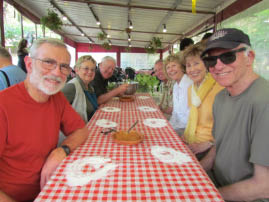
Eating our pita bread |
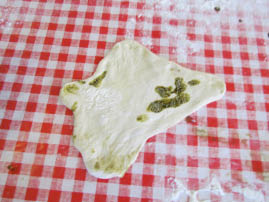
Home made pita
|

Shosh showing Mitzy how to make pita |
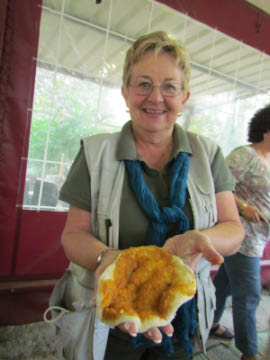
Pat with her pita |
After I finished eating mounds of food, I left the group and went out to explore this magical farm. I happened to bond with one of “the help” – a 17-year old girl named Orian. It was as if we’d always known each other. I shared with her words of wisdom and she said, lovingly, that I was older than her country (true statement). I gave her a great big hug and didn’t want to say good-bye.

Orian and friend |
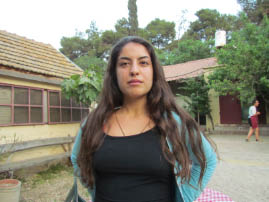
Orian |
We piled on the bus, fat and happy and forever changed by our meeting with Ehud and Shosh. We arrived at our hotel about 8:30 in the evening. (Yael was in big trouble. She lives on the outskirts of Nazareth and needed to be home to check in on her family – but the night went long.)
Our hotel (Golden Crown – Old City) is in the center of the city (Nazareth) and we really liked the hotel manager – a sweet guy who once lived in San Diego and returned with his family to his homeland. However, the hotel is unfinished and badly organized – bad floor plan, no hair dryer, no safe and no place to hang the clothes that Bill had to wash. Take the good with the bad.
5/4/12 - Friday (Shabbat) -- good to be in an Arab town – Nazareth
We had breakfast at the hotel on the top floor in a round room with views overlooking Nazareth. I liked our “bird’s eye” view of the city and took lots of pictures. I could tell it was going to a beautiful day. For those of you who may have forgotten, Nazareth, now a Muslim town, is where Jesus spent his childhood.

Nazareth |

Nazareth
|
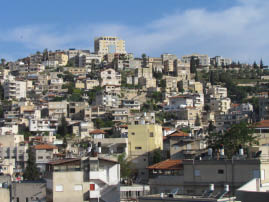
Nazareth |
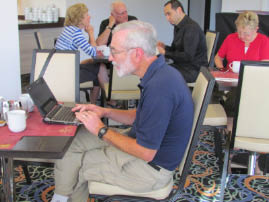
Bill catching up on the news. |
We boarded the bus for the historic coastal town of Akko, an UNESCO World Heritage Site Built on ancient stone walls, the city is perched on the Mediterranean Sea and only about 30 miles away from Nazareth.
Akko, a port-city, was a settlement from the Phoenician period and has been inhabited ever since. Its port was first mentioned in 527–525 BC when the Greeks were out to conquer Egypt. Akko became an international port city and gateway to Israel during the reign of Ptolemais II (285-246 BC). At the height of glory and power, Akko was the capital of the Crusader Kingdom in the Holy Land during the conquest of the Crusaders in the 13th Century.
About 1750, the Ottoman Empire came to conquer, building their city over the ruins of the old Crusader Fortress. The port was left to decay and is now reduced to a fishermen’s harbor. After WWI, the British picked up Akko as a spoil of war. It’s pretty amazing to think of all the history tucked in Akko’s layered ruins left from the Canaanites and Romans to the Crusaders, Turks and British. Akko was prime real estate and thus, a magnet for the toughest of warriors and the meanest of rulers.
Before we entered the old walled city, we made a stop at a souvenir shop that specialized in copper pieces – jewelry, serving platters and so on. The shelves were lined with beautiful things, but too pricey for my blood. The proprietors of the shop were a family from Iran who passed their artistry and trade down for many generations. The kid from the now generation demonstrated his skills by pounding out a copper bracelet in a few minutes and giving it to Mitsy, a perfect choice. (We waited a little longer for Carol to caress some earrings in a case – she’s powerless over herself, much to Richard’s chagrin.)

Akko Souvenir Shop |

Akko Souvenir Shop
|
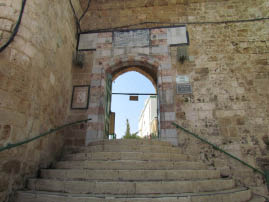
Akko |

Yael at Akko |
Once we had satisfied our shopping needs, we were ready for Akko. Akko is unique because it’s like visiting two distinct cities that just happen to share the same name and vertical space. On the top layer (street level) are the leftovers of the Ottoman Empire (18th and 19th centuries) -- the citadel, mosques, markets, bathhouses, caravanserais and cemeteries. Buried below is the medieval Crusaders' (1104 to 1291) well-preserved subterranean city with a citadel and grand halls where the Knights from the Templar and Hospitaller clans gathered.
el-Jazzar Mosque
We started our tour on the ground level, visiting
the huge and impressive
el-Jazzar mosque. Built in the Ottoman Turkish style, it took only one year to complete (1781-2). Pretty amazing considering it was the largest mosque in Israel outside Jerusalem. It once had a silvery-white dome that glittered at a great distance, but now is painted a boring forest green.
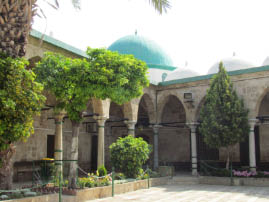
el-Jazzar Mosque |
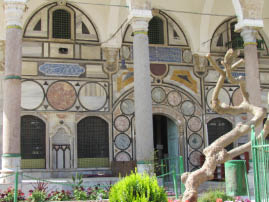
el-Jazzar Mosque
|
Ahmad Pasha el-Jazzer, called "The Butcher," built the mosque and is now laid to rest alongside his adopted son next to the mosque. Ahmad el-Jazzer succeeded Dahr el-Omar after having him assassinated and then ruled Akko from 1775–1804. He was the baddest of all rulers. If he didn’t like your nose, your ear, your hand, he’d cut it off. He once heard that one of his 37 wives was cheating on him. He went to the palace, brought all 37 wives out for interrogation and when he couldn’t figure out who the culprit was, he killed every last one of them – now that’s bad!
el-Jazzer was famous for his impressive public works (like the mosque), his cruelty, and for defeating Napoleon at Akko in 1799. The city withstood Napoleon's two-month siege and that ended Napoleon's campaign to conquer the Middle East.
We stood outside the front of the el-Jazzar mosque while Yael explained the importance of the 4 main colors in the Islamic design – yellow (sun), blue (sky), green (grass – fertility) and red (can’t recall). We went inside the huge area where one middle-aged Muslim was praying. Yael told us that the mosque houses one hair from the beard of the Prophet Mohammed. The strand of facial hair was once paraded regularly through Akko ending the fast of Ramadan, but now is tucked away and shown only to the congregation on very special occasions.
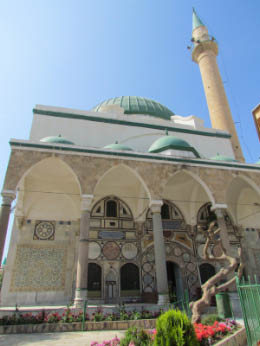
el-Jazzar Mosque |
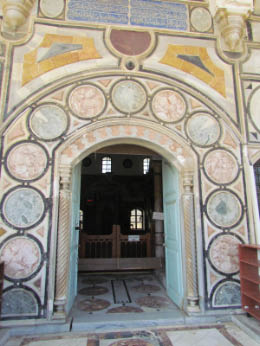
el-Jazzar Mosque
|

el-Jazzar Mosque |
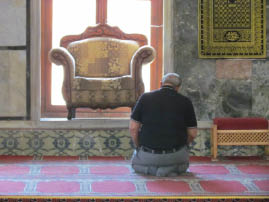
el-Jazzar Mosque |
Center for Sufi
We walked to the El-Shazliya Mosque built over former Muslim and Christian prayer houses and other Crusader buildings. The mosque has a complex of rooms and is the Sufi world center of the Shadilli Yashruti order. The Sufi complex was built in 1862 by the founder of the Dervish order in Akko (of the whirling Dervish fame). (I knew nothing about the Sufis before my visit.)
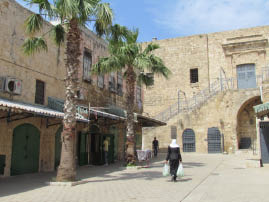
Center for Sufi |
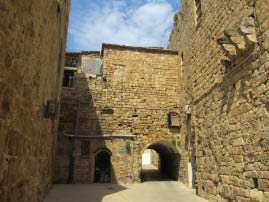 Center for Sufi
|
The story of the Sufi Sect in Akko:
In 1841 a young sheikh, Shaykh al-Din al-Yashruti (also called "the North African") was coming from North Africa on his way to Mecca. As several religious sects begin, a prophet (named Yunis of Jonah) appeared to "the North African" in a dream and ordered him to go to Akko (then the capital of Palestine) to renew the religion of Islam.
The young sheikh arrived in Akko in 1849 and by 1862, established a new Sufi order. He built the zawiya (assembly) and transformed Akko into the world's spiritual center of the Sufi Shadhili order. Centers were also built in Damascus, Beirut, and other places all over the world. They have about 4 million people and the current leader is Professor Ahmed Yashruti who was the personal lawyer for King Hussein of Jordan, and is leading the order from Amman. The founder ("the North African") died in 1895, leaving his son in charge until 1922. The grandson took over for almost 60 years until he died in 1980.
The core Sufi belief is to love all humanity. With the world in such turmoil, especially in the Middle East with Christians and Jews and Muslims at each other, they believe it’s time for mental and emotional purification. The sect still speaks out against violence and speaks for tolerance, especially from the Arab side.
At the most troubled time, the grand sheikh gathered up the sect and fled for safety to Beirut. The order was saved from destruction, but it took the order some years to get their properties back in Akko. Now they are rebuilding the El-Shazliya Mosque, a huge and beautiful complex in Akko, due to be finished within a year. Yael told us that the Sufi’s are also buying up land in Akko like crazy -- using their funds to invest in the future of Akko – take note – Akko might be a good investment!
Construction crews were renovating the old castle complex as we entered one of the large, open rooms. I liked the way they left parts of the ancient Roman subterranean plumbing exposed under Plexiglas. Those Romans were something. |

Center for Sufi |
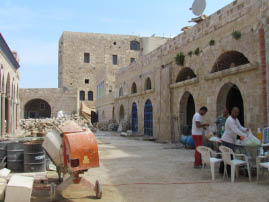
Center for Sufi
|
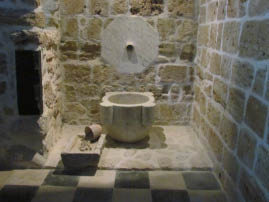
Center for Sufi |

Center for Sufi |
We all sat quietly in a large room and listened to a gentle guy, who seemed very holy, tell his story of how he became a Sufi devotee. I didn’t get his name, but his story and his honesty touched me. In his younger years he was working for Rabin. At that time, he was engaged to an Egyptian woman. In his heart he knew he didn’t love her and in fact, his words, “I couldn’t make sex with her.” No one knew his personal story. At the same time and for no reason, Rabin insisted that our gentle man go and meet a particular Sufi rebbi. Finally he did. After a few “hello’s” and “how are you’s,” the rebbi immediately told him to drop the girlfriend. That advice came out of the blue, so the sweet guy goes back and breaks up with his finance … and changes his life. He found a good woman and became a Sufi.
He told us the basic principles of his religion -- Listen / Meditate / Don’t Judge / Respect Others. Our gentle guy said we all connected, especially when we meditate. He pointed out a marble design on the floor that showed us each as individual red circles. When we meditate we move along the connecting lines toward the center where we become one. Through meditation, the rebbi was shown that our guide should dump his Egyptian girlfriend – and the rest is history.

Marble design on the floor |
Our next stop was the tour of the Turkish "hammam" baths. An older confused guy at the ticket counter had a problem resetting the audio program on the headsets, so we were delayed while he got it together and found a younger techno-type to sort things out. It was frustrating, but the 30 minute multimedia show called “The Story of the Last Bath Attendant,” was well worth the wait.
We entered the actual bathhouse built for el-Jazzar (AKA “The Butcher) in 1781 and used continuously until 1947. The building was spectacular with exquisite floors, gorgeous ceramic tile and domed rooms lit from above with glass bubbles.
The tour started in the dressing room where we were introduced to the five generations of the family (most likely fictitious) who managed the bath. We were led through a series of hot rooms into a large hexagonal steam room with a marble fountain where statues portrayed the bathhouse clients and staff. Through our headphones, we heard the manager ordering the clients around, throwing hot water on them, scrubbing them raw and torqueing their bodies. I went away realizing how much town gossip along with business was conducted during those bath house treatments. It was indeed a good old boys’ country club with lots of teasing and kidding that comes with forging alliances and making bonds in business and in life.

Turkish Baths |

Turkish Baths
|
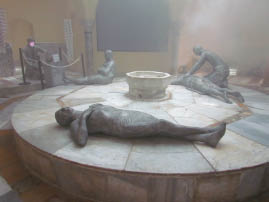
Turkish Baths |
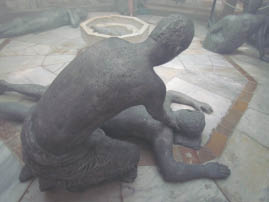
Turkish Baths |
We returned to streets of Old Akko – passing through alleyways, inner courtyards and the old marketplace. Yael treated us to fresh squeezed orange juice in one of the inner courtyards. We bought one of those gluey mixed nut rolls – oh so very good. We were now fortified and ready to see the Crusader’s section of town, most of it tucked below the old Ottoman city.
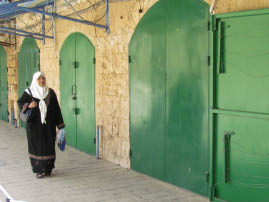
Old Akko |

Akko
|
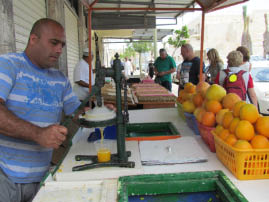
A refreshing orange juice |
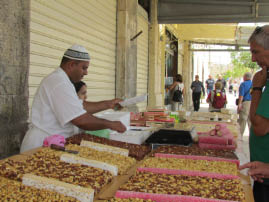
Akko |
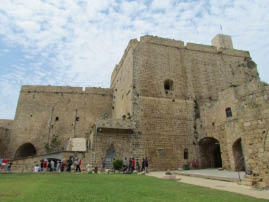
Akko |

Akko |
Akko is the home of the famous Crusader fortress. Built upon the ruins of the old Roman city, it is the best-preserved Crusader city in the world with new sections being opened with the on-going research. You get a good look at how the Crusaders lived and worked in the late 1100s. Yael bought our tickets and then led us through an amazing maze of the most fascinating underground tunnels and subterranean grand halls. We wove in and out of the different levels passing by the citadel, courtyards, and massive halls. I was on overload so I’ll do my best to sort out what I saw and what I learned. (I am open for correction.)
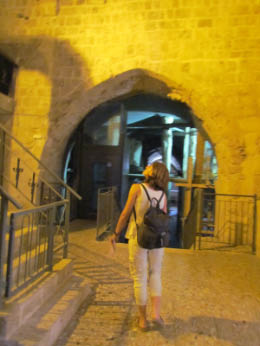
Akko Crusader Fortress |
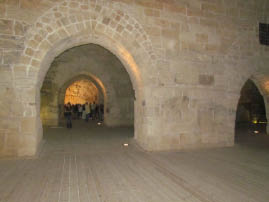
Akko Crusader Fortress |
What tweaked my interest most was the stuff left behind by the Crusader Knights (probably not always decked out in shining amor). The Knights of the Templar and the Knights of the Hospitallers were secret societies organized like a union, much like the Masons. They were monastic military orders and always fighting each other. The Hospitallers was the trade union associated with a hospital in Jerusalem. The Templar knights, in their distinctive white mantles with a red cross, were among the most skilled fighting units of the Crusades. Non-combatant members of the Order managed a large economic infrastructure throughout Christendom that was an early form of banking. The Hospitallers moved their headquarters from Jerusalem to Akko in 1191 where they remained for 100 years.
The Knights of the Templar popped onto Western radar, thanks to the book and movie, “The Da Vinci Code.” Tom Hanks had us all thinking that clues from Leonardo’s paintings blew the cover off the two thousand-year old secret society (Templar Knights) and shook the foundations of Christianity with concepts like Jesus was married and had a kid. Da Vinci was a member of Templar Knights and was involved in some strange stuff – but hey, I digress.
The Templers figured out branch banking. Before the warriors, government officials and even royalty left their homes to travel to the Holy Land, the Templars collected their money and gave them an “IOU.” Dressed as monks, it was easy to smuggle money and transfer funds. One of their very important customers, French King Phillip IV, got pissed off because he didn’t like having someone else messing with his money. On a Friday the 13th, he sent his henchmen to arrest all the Templars. Because of that massive swat action, Friday the 13th is renowned. Those that weren’t killed went underground.
Yael led us through a courtyard and then to the Crusader City Center of government (Grand Maneir) held up by massive pillars, some with France’s Fleur de lis still visible – left over from the Crusader times.
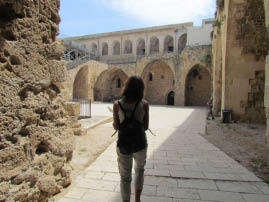
Yael led us through a courtyard |

Crusader City |
We went down a series of stairs and through a narrow passageway, I believe. We were right below the citadel and prison of Akko as we wondered through a complex of halls, built and used by the Hospitallers Knights. There were six massive semi-joined halls, one recently excavated large hall, a dungeon, a knights' dining hall (misnamed the Crypt because of its depth) and the remains of an ancient Gothic church.
We saw hall after hall of deep caves below ground, with more caves being excavated. Yael said when they found these huge underground halls, they were emptied of any possessions (not a treasure to be found) and filled with sand. The sand made a more solid foundation for the Ottomans to build their city and wall above.
We saw part of the Templar Tunnels, an underground passageway built from their main fortress to the port, a strategic linking the fortress to the port – very important for moving people and funds.
We made a stop to view the 3-story high latrine, well-engineered with a row of crappers. We could only imagine the smells!
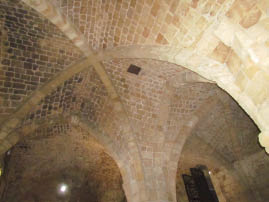
Templar Tunnels |
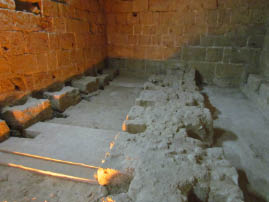
Templar Tunnels |
We emerged back on ground level in the citadel of Akko, the Ottoman fortification. We looked out at an enclosed courtyard that was once a grand caravansary called the Khan al-Umdan, meaning 'Inn of the Pillars.' It was built by that old Butcher himself, Al-Jazzar, in 1785. The pillars that give the places its name were looted from Caesarea. It was a two story structure -- the animals stayed on the ground floor while their merchant owners slept upstairs. It served mostly large camel caravans bringing in grain from the hinterland. Today, several hotel owners are interested in turning it in a posh get-away, but, according to Yael, all the deals seem to fall through. I’m glad. I like it the way it is.

Courtyard |
There was so much to see and do in Akko. I’m sorry we missed the Museum of Heroism which was once used by the British as a prison for activists of the Jewish Zionist resistance movements. Many prisoners were executed there. The book “Exodus” tells some of the heroic stories.
We left the ancient city and strolled along the seawalls of Pisan Port to our lunch spot, Doniana, an elegant fish restaurant overlooking the marina and fishing port. I sat next to the bus driver – We were kept from small talk by language barriers -- so we just smiled and passed the ketchup back and forth. The fish was excellent!

Seawalls of Pisan Port |
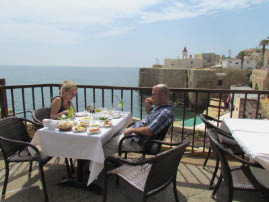
Doniana Restaurant
|
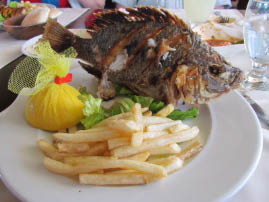
Lunch |
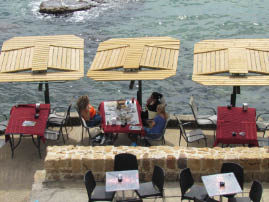
View from the Restaurant |

View from the Restaurant |
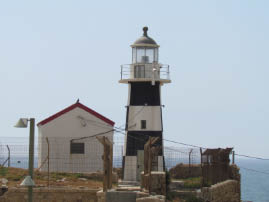
View from the Restaurant |
When we got back to the bus, Ted discovered he forget the new memory card he bought for his camera and had to dash back to the restaurant to do a garbage search – always something.
We drove north passing through lots of banana groves covered with netting. The netting keeps the moisture in and reduces the watering by 30%.
We arrived at the border of Lebanon and got a great view of the Israel’s Mediterranean coastline. We rode the 2-minute cable car down to the lower level to see the sea grottoes of Rosh Ha Nikra. The white cliffs, with flint stones mixed in, were stunning.
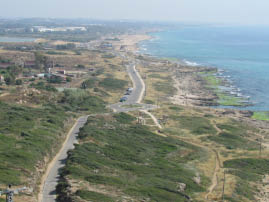
The Israeli Coast from Rosh Ha Nikra |
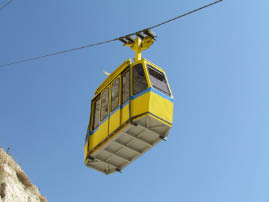
Cable car to the grottos
|

Tourquois Mediterranean |

Entry to the Grottos |
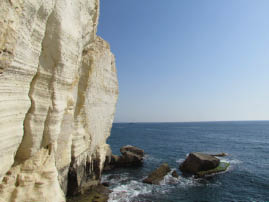
Cliffs of Rosh Ha Nikra |

White Cliffs |
At sea level, we saw the remains of a railway line built in 1943 by the British to connect the Middle East and Europe, extending the Cairo-Tel Aviv-Haifa line to Beirut. It carried weapons and soldiers in the war against Hitler. In the summer of 1944, it carried Jewish refugees from the concentration camps to Israel, but was never used for public transportation.
With herculean effort, the railroad was built in one year with the help of thousands of workers -- Australians, New Zealanders, South Africans and the locals. They blasted out tunnels in the hillside and constructed a couple of suspended bridges to connect the track through the tunnels.
Yael told us the story of the heroic Carmeli fighters (of the Haganah - Israelis) who blew up the bridge suspended above the big grotto opening on a stormy night in March 1948 to prevent Lebanese weapons and soldiers from passing into the territory that would become Israel. With such bravery, they went against the British and now are legendary.
We walked through the tunnel and the caverns. The sound of the water in those carved out caves made a powerful, eerie sound that I will not forget. It was like being inside one’s own body and hearing your blood and guts sloshing around.
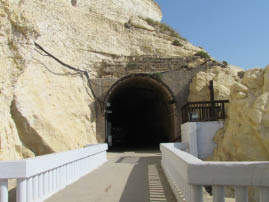
Entry to the Grottos |
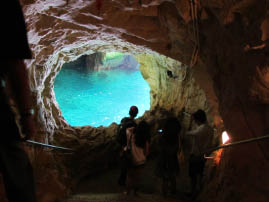
The Grotto |
We watched the Rosh Ha Nikra orientation video, shown in one of the RR tunnels. We learned about a beautiful Arab woman on her horse, making her way to her wedding. She was in a large group of riders, but at one point, she took off running, forcing her horse to jump over the cliff. The bride would rather die than marry the man her father had chosen.
The video also told about the famous railway built here. In general, the video was your average, run of the mill intro film until the scenes of the powerful waves came on screen. At that point, the audience, seated in the dark, cold tunnel, was splashed with water. Gave us all a good laugh. Now how cool is that?
We rode the lift back up to the top and stopped at the Lebanon “border.” Yael did her military service here and told us about the 2006 war with Lebanon. The Lebanese started it by kidnapping some Israeli soldiers– one was just freed not long ago. However, the leaders in Israel over-reacted, the war spun out of control and Israel ended up losing the war.
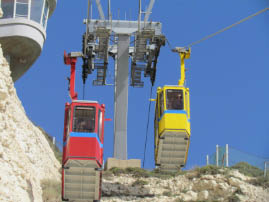
Cable Cars |
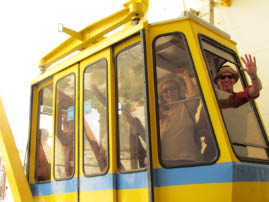
Our Group |
On the way back to Nazareth, we made a pit stop at a convenience store. Yael treated us all to a Magnum ice cream bar. Bill was so happy – he loves Magnums. I wanted a beer!
Before our dinner at the hotel, Yael conducted her traditional Shabbat service on Friday, before sunset. She gave a blessing along with a little family history. (Her father couldn’t carry a tune – so she apologized in advance for her slightly out of tune blessing.) It was a nice touch (and a nice bottle of wine). Thanks Yael.
We had dinner at a table with Dean and Mitsy. It was nice to get to know them.
It’s Friday and a good day to be in an Arab town. All the Jewish towns shut down at sundown and don’t open up until Sunday about 6. They’re very serious about that.
|











